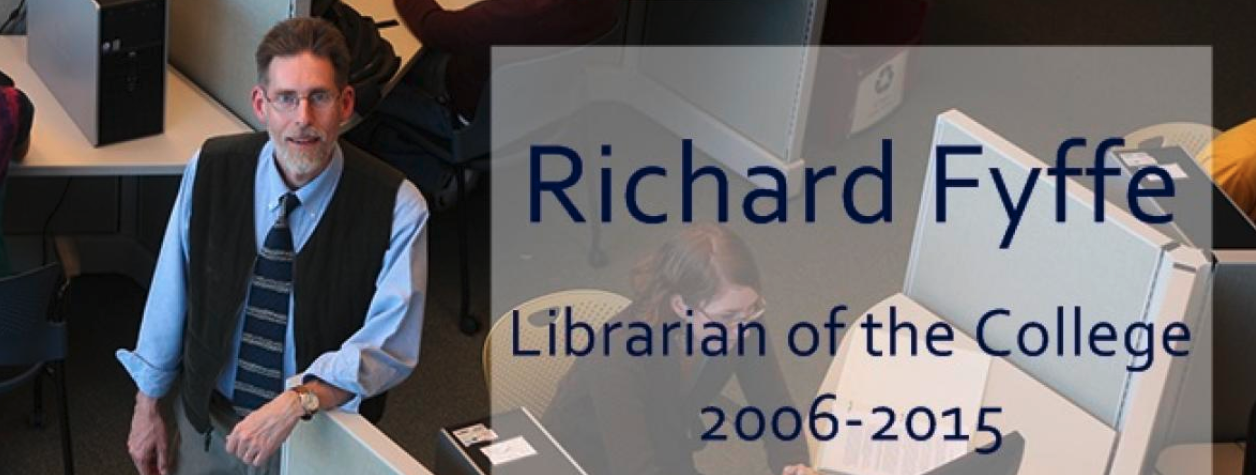Until his untimely death from ALS in November, 2015, Richard Fyffe had served as Librarian of the College since coming to Grinnell ten years ago. Richard worked tirelessly to enhance library operations at the College and build a strong staff of professionals and support personnel, and his contributions in this area have been publicly recognized by Grinnell College President Raynard Kington and Dean of the College Michael Latham on several occasions.
Richard’s contributions extended well beyond the library, however. At the time of his death, he was chair of the Science Division, and over the years he had served on a wide variety of College committees—an expression of his passion for the liberal arts and of his own eclectic talents and interests. One of those committees was the Center for Prairie Studies Advisory Board, of which Richard was a member from 2012 to 2014.
Richard’s interest in the prairie region began when he was living and working in Lawrence, Kansas, and after moving to Grinnell, his next place of employment, it did not take him long to visit the College’s Conard Environmental Research Area (CERA), a 365-acre nature preserve, a significant portion of which is given over to prairie restoration. CERA eventually became one of Richard’s favorite places for walks, quiet contemplation, and the enjoyment of nature. His wife, Ida, asked that his memorial service be held there.
Richard’s contributions to Prairie Studies were many. He participated actively in board discussions, invariably bringing his characteristic intelligence, wit, and insight to our deliberations. He played a significant role in shaping the Center’s programmatic theme—“The Commons: the natural and cultural resources available to groups of people for shared use”—for the 2013-14 academic year. As a librarian, Richard was especially interested in the information commons, and he was instrumental in arranging for David Bollier, a preeminent scholar of information (and other) commons to come to the College to speak in the Center’s series that year.
Faculty member John Whittaker recalls serving on a College task force charged with “exploring open access and digital dissemination of Grinnell’s scholarly work” that was headed by Richard. I should say spearheaded to emphasize how effective he was. Richard worked tirelessly to produce policy for the college and get it up on our webpages, and to create ‘Digital Grinnell’ as a vehicle. For those of us interested in Prairie Studies at Grinnell, Richard’s work was instrumental in setting the stage for open access digital productions, including Rootstalk.”
Another colleague (and current Center board member), Cori Jakubiak, worked with Richard on the search committee to hire a director for the College’s Writing Lab. “What struck me throughout the process,” she remembers, “was Richard’s unfailing grace and generosity. He took a sincere, measured interest in every single person who applied for the position, and he interpreted any and all application materials charitably. I recall feeling pleased and lucky at the time that I’d had the opportunity to work so closely with Richard. Unknowingly, too, Richard modeled professional kindness and wisdom to a younger colleague.”
My own most memorable collaboration with Richard involved a photograph from Kansas. Wes Jackson, the founder and director of The Land Institute, an agricultural research and education organization in Salina, Kansas, dedicated to re-shaping the nature of American agriculture based on principles of prairie ecology, came to Grinnell to speak. Richard was familiar with the work of The Land Institute from his time in Kansas, and I, along with several other faculty members, had visited “The Land” several years earlier to learn more about Jackson’s vision and path-breaking efforts.
As he was remarking on the important role of the prairie’s remarkable root system in holding soil, Jackson suddenly rolled out onto the floor an eighteen foot long life-size photograph of a complete specimen—stems and roots—of big bluestem, one of the signature grasses of the tallgrass prairie. The impact of seeing the plant’s full mass of roots was electrifying, at least on Richard and me, and after the lecture we talked excitedly about trying to acquire a copy of the photograph. As it turned out, The Land Institute was selling copies, and also had another available for sale of a compass plant, with an even deeper root system than big bluestem.
Pooling funds from the library and Prairie Studies, we acquired both photographs, and they now hang in Burling Library helping to educate students about the natural history of the prairie region. The image on this page shows Richard dwarfed by the poster photo of big bluestem, one of his favorite prairie plants. What I see is big bluestem hanging next to one of my favorite prairie ramblers. Thank you, Richard, for all you did to enrich our lives.

Photo courtesy of Jonathan Andelson

